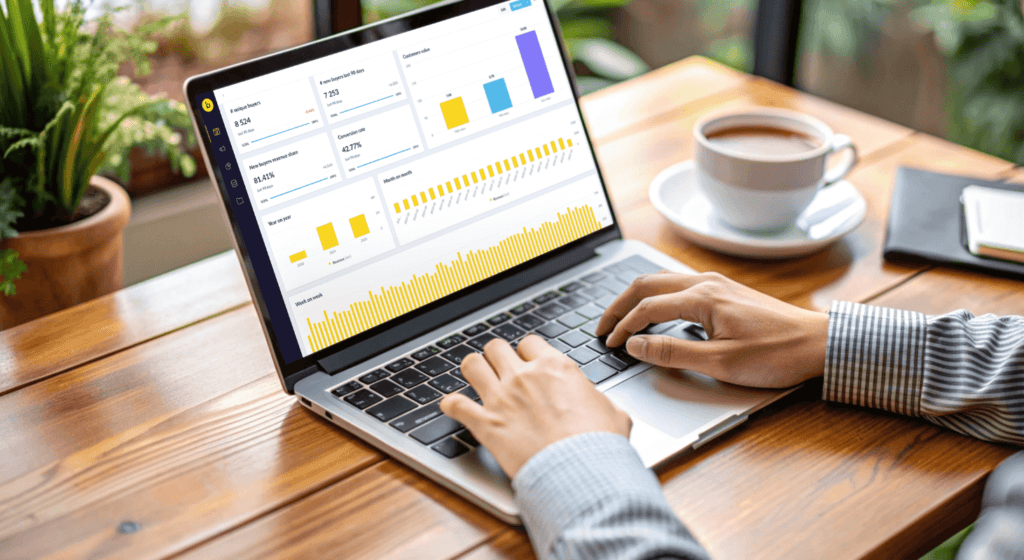Between customers, campaigns, and competitors, ecommerce marketers have their hands full.
Most days, there’s hardly a moment to spare, let alone time to become a data analyst. But with customers generating mounds of data every day, ignoring it isn’t an option.
Ecommerce analytics tools can turn chaotic data into a smooth ride. These tools take care of the numbers, so you can focus on what you do best: growing your ecommerce business and dominating your competition.
Keep reading to learn more about what these tools do and how to select the best one for your needs.
What Do Ecommerce Analytics Tools Do?
Gathering data from your ecommerce store helps keep your business on track. Ecommerce analytics tools collect and make sense of all the data your ecommerce site generates. These customer analytics platforms expand and contract to fit your needs, from high-level overviews of market trends affecting your ecommerce business to granular data about individual customers.
With this information, you can easily identify patterns and spot opportunities to improve your digital marketing and customer acquisition. A campaign to promote hiking gear may perform well in email channels but not on social media. Being aware of this can inspire you to pivot your strategy.
Whatever your budget or goals, there’s an analytics tool for you. Basic tools offer standard reports and metrics, like sales performance, traffic sources, conversion rates, and average order value. These tools provide valuable insights into how your marketing campaigns impact your online store’s performance.
More advanced analytics tools provide real-time sales data, predictive analytics, and custom reports, maximizing your digital marketing efforts in various ways. For example, an advanced marketing analytics tool can show you which customer groups and marketing channels perform best during a holiday sale, helping you adjust your messaging and inventory to boost results.

Advantages of Investing in Ecommerce Analytics
Investing in ecommerce analytics tools means investing in the future of your business. Here are a few undeniable reasons why you should consider this investment:
Stronger Decision-Making
Ever tried shopping for a recipe without knowing the ingredients? As you browse the grocery aisles, you hope you’re picking the right items and that your dinner turns out well.
Ecommerce marketers face a similar dilemma when optimizing their campaigns or planning for the future without the right customer data. It’s time to stop crossing your fingers and hoping for the best. Ecommerce analytics provides the data-driven insights you need to succeed, while also saving time and marketing spend. It’s no surprise that 97% of business leaders want data to guide their operations, with 44% specifically looking to enhance their decision-making.
Better Customer Understanding
For years, marketers created an ideal customer profile and tailored campaigns around it, assuming customers would move along the sales funnel as expected. In 2024, basic demographics like age and gender aren’t enough; you must understand customers’ specific needs and how your product can help.
This is where ecommerce analytics tools shine. These tools analyze sales data and reveal customer insights that might go unnoticed by human eyes, which in turn will help you enhance customer engagement. For instance, customers who purchase new luggage may be significantly more likely to buy packing cubes within a week. Knowing this allows you to target your product recommendations accordingly, heighten customer retention, rake in more sales, and enjoy a sharp advantage over your competitors.
Improved Marketing Strategies
Monitoring your digital marketing campaigns can be challenging. It’s impossible for human team members to watch campaigns 24/7 and constantly evaluate the results — but automation can.
With help from machine learning and artificial intelligence, ecommerce analytics tools study campaign results and distill the information into the most relevant takeaways for your marketing team. Your team can use these actionable insights to inform your marketing strategy and achieve better ROI. Not to mention, clear data visualization makes it easier to sell your marketing ideas to your boss, so you can roll out bigger and better campaigns next time.
Key Features To Look for in Ecommerce Analytics Tools
Many ecommerce analytics solutions claim to be the best, but what features truly define a solid tool? Here are a few things to look for:
Real-Time Ecommerce Data
Customer data is always changing, and the numbers you received yesterday may be irrelevant today. Collecting real-time data as it rolls in ensures your team always has the most accurate picture of your customers’ brand interactions. This always-fresh first-party data helps you understand what your customers are doing right now, so you can make changes to your marketing plans at a moment’s notice.
Let’s say your platform shows a sudden increase in website traffic from a particular social media site. You quickly adjust your ad spending to take advantage of this trend and reach more people before you lose this momentum. Without real-time data, you might miss this trend and lose out on potential gains.
Customer Behavior Tracking
Customers are creatures of habit with unique purchasing patterns. Understanding what they add to their online shopping cart and where they buy is must-know information if you want to level up your marketing game and boost customer lifetime value.
Ecommerce analytics tools do more than track the types of products your customers buy. They also reveal insights into customer preferences like their most-used channels (e.g., in-store, online, or SMS). By knowing where and how your customers engage with your brand, you can refine your digital marketing strategies to target the most effective channels and avoid approaches that don’t work.
These tools also help identify larger purchasing patterns and trends. For example, as a clothing retailer, you might see a shift from festival clothing to swimwear as spring turns to summer. This insight allows you to adjust your inventory and provide a personalized customer experience, increasing satisfaction rates by at least 20%.
Sales Performance Analysis
Introducing new products and managing existing stock can be challenging. In the past, ecommerce businesses didn’t have tools to help them predict what would sell or how much to keep in stock, so they mostly relied on guesswork. This made it hard to avoid running out of popular items or ending up with too much stuff.
Customer analytics tools make these issues a thing of the past. They offer the sales performance analysis needed to identify top-performing products, understand sales trends, and forecast how well these products will perform in the future. With this data at your fingertips, you’ll no longer have to guess whether a new product variation will succeed or risk ending up with too much or too little stock by the end of the season.
Customizable Dashboards
Ecommerce analytics tools spit out a lot of data. To make sense of it all, you need a dashboard that’s easy to understand. Look for providers that offer user-friendly dashboards that present data clearly, without overwhelming your team with complex numbers.
Providers like Bloomreach offer dashboards that are easy to understand and require no advanced coding or technical knowledge. This helps your whole team break down information silos and understand how your brand is doing. This addresses a common issue faced by many marketers — only 23% strongly agree they have the quality audience data needed to make the most of their budgets.
Best Practices To Keep in Mind When Using Ecommerce Analytics Software
The best ecommerce analytics tools are flexible and can adapt to any team’s workflow. However, to get the most out of them, it’s important to follow these best practices:
Set Clear Goals for Data Analysis
The saying “you can’t manage what you don’t measure” rings especially true in ecommerce. Before diving into ecommerce analytics, work with your team to clearly define your goals and key performance indicators (KPIs). For instance, if boosting email campaigns is a priority, tracking click-through and conversion rates should be key focus areas.
Bloomreach lets you focus on what matters most without losing sight of the big picture. You can drill down into specific areas, like email performance and customer attribution, without getting buried in irrelevant data or losing sight of other, higher-level information. This helps you make better decisions faster.
Regularly Review Your Analytics Data Metrics
Once you’ve identified the data most relevant to your goals, it’s important to check in on your goals and numbers regularly, including your rankings, so you can see what’s working, what’s not, and the potential areas for improvement. This allows you to tweak your campaigns based on what the data tells you.
Bloomreach’s intuitive analytics platform means you don’t need advanced technical knowledge to interpret the data. Our dashboards’ ease of use makes reviewing your data regularly a breeze, unlike more complex ecommerce platforms that can be intimidating and time-consuming.
Integrate Ecommerce Analytics Tools With Other Software
Got a marketing tech stack? Good! Success in marketing doesn’t happen in isolation; it requires a combination of tools to execute and analyze your most ambitious campaigns.
Your ecommerce analytics software is a key player, but it needs to work well with your other solutions. Bloomreach offers over 140 integrations with software that ranges from CRM to instant messaging and everything in between. These integrations give you a complete view of your business and the most relevant information about user experience, so you can make smarter decisions based on all your data, not just one piece of the puzzle.
How Bloomreach’s Ecommerce Analytics Solution Stands Out Against the Rest
Bloomreach goes beyond traditional web analytics, offering a suite of AI-powered ecommerce analytics tools to unlock a rich understanding of your online business. Instead of sifting through endless data points, Bloomreach’s Loomi AI analyzes user behavior and purchasing trends for you, allowing you to make data-driven decisions that advance your campaign goals.
This starts with real-time reporting. Bloomreach provides instant access to key metrics, allowing you to react to customer behavior shifts and perform campaign optimization on the fly. Our platform also seamlessly integrates with various data sources, so you can get a full view of how well you’re performing from all angles.
We take things further with capabilities like:
- Predictive analytics to anticipate customer needs and preferences
- Customer segmentation to tailor your approach based on audience groups
- Automated reporting to free your team from manual work so they can focus on strategic initiatives
Plus, Bloomreach’s intuitive interface and customizable dashboards put self-service in your hands. No more relying on your technical team to interpret the data you collect — Bloomreach clearly reveals the trends you need to know in a way that’s accessible to everyone on your team, regardless of their technical expertise. When everyone contributes to more informed decision-making, your brand creates a well-rounded, highly profitable customer journey.
Build a Stronger Ecommerce Strategy With Bloomreach
Things move fast in ecommerce. To thrive, you need quick insights, not a data science degree. Ecommerce analytics tools turn complex data into simple answers, providing a way to track your wins, analyze the bigger picture, and outshine your competitors like a pro.
The journey to data-driven excellence starts with Bloomreach and its powerful ecommerce analytics tool. With features like customer behavior tracking, sales performance analysis, and customizable dashboards, you can track real-time data for up-to-the-second analysis. This helps your brand stand out and boost your marketing efforts with smart decisions and strategies that really connect with your audience.
Bloomreach turns your data into dollars. See how by scheduling a free demo.













